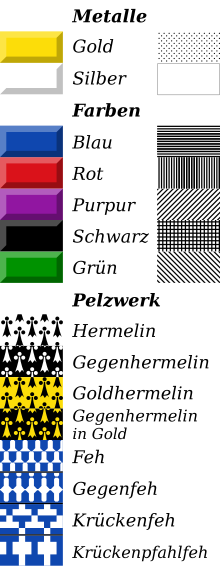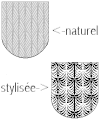Tinging
Tinging is the coloring (tincture) of the coat of arms . The heraldry's inherent demand for rich contrasts in the heraldic symbols led to the restriction of the coat of arms to a few colors as well as the fur on the helmet covers and crest decorations .
tincture
The heraldic tinctures are the colors used for coloring . A distinction is made between the actual colors , metals and heraldic fur .
“Heraldic colors (tinctures), coat of arms or herald colors, in the old heraldry only six in number u. Black, red, blue, green (and possibly purple for tinging the gems), as well as gold and silver (the 'metals'), for which yellow and white are often used. The black is the ivory (or Russian Black), the red cinnabar (in earlier times also minium ), the blue light cobalt (od. Mountain) Blue, the Green, the so-called. Emerald green . For gold, you use real gold leaf, for silver usually platina, since base metals will soon oxidize. "
When a coat of arms collection is published such as the content of a coat of arms roll , the named nominal colors are printed with the same color for all coats of arms. Since printing with several colors was originally very complex, a uniform system of hatching with dots and lines prevailed so that the pictorial publication of coats of arms can always be read correctly even in black and white printing.
In the tables below, the "Metal" or "Color" field shows the color and the corresponding hatching next to it.
Metals
Gold and silver are referred to as metals in heraldry . Gold can be replaced with yellow , silver with white . In heraldry, gold and yellow are to be equated, as well as silver and white. In heraldry, yellow and white therefore appear under the metals and not under the colors described below.
| metal | German | French | English | presentation | hatching |
|---|---|---|---|---|---|

|
Gold yellow |
or | or | Usually yellow. Gold leaf (or metal leaf ) was also used for coats of arms . | dotted |

|
Silver white |
argent | argent | Usually white. Coats of arms can also be made of silver leaf (or imitations). | empty field |
Technical difficulties of reproduction gave rise to heraldic errors. Silver becomes black through oxidation and gold, which had to be underlaid with red lead, flakes off so that only the red basic color remains. So z. B. the black (actually silver) ram's head of the von Rechenberg - Haugwitz family .
Colours
Heraldic colors
Among the colors are, by definition, red, blue, green and black. All colors are only reproduced in a uniform, strong basic tone. Variations such as light blue, royal blue , deep blue are absolutely permissible for individual representations (for example above a portal ), but only the "blue" remains heraldically relevant.
| colour | German | French | English | Presentation, notes | hatching |
|---|---|---|---|---|---|

|
red | gueules | gules | Cinnabar , are not permitted pink or carmine (purple). In exceptional cases, the fur "marten" is also shown. Gueule means throat in modern French. | vertical lines |

|
blue | azure | azure | Glaze from the semi-precious stone lapis lazuli (deep blue), rarely also azurite ( turquoise blue ) | horizontal lines |

|
black | sable | sable | The French and English names sable originally refer to the black fur of the sable . The words sable and sable come from the same Slavic word. | latticed (or completely black) |

|
green | sinople | vert | Sinopia is a red-brown natural color, named after Sinope in Asia Minor. Correspondingly, in French blazon , sinople was originally a red shade. For unknown reasons, the meaning changed in the 14th century, since then sinople means "green". Previously, vert - still the usual French word for green today - was the name for green in coats of arms. The English heraldry in turn adopted the French vert . | Lines sloping downwards |
Natural colors
Other colors are avoided and usually only appear for subordinate components of coats of arms. A different tincture for common figures is often emblazoned as "in natural colors" , with which the color tone is usually sufficiently determined, for example for fur (brown), skin (pink) or walls (gray). The reproduction of heraldic figures in natural colors contradicts the principles of heraldic representation and is therefore rarely used. B. in animals and humans. These natural colors are not subject to the rule of alternating metal and colors .
The natural colors should be converted into the closest heraldic color. A tree trunk would then not have to be colored brown, but red. In addition, it is permissible to color all objects in all heraldic colors. So a lion can be green or blue.
Uniform hatching has also established itself for the different coloring.
| colour | German | French | English | Remarks | hatching |
|---|---|---|---|---|---|

|
purple | pourpre | purple | There are numerous examples of purple as a shield color in England and France. In German heraldry, however, purple occurs only as a tinging of hats, crowns, coats of arms and the inside of helmets. | Lines diagonally upwards |

|
brown | brunâtre (or similar color: tanné, tenné) |
brunâtre (or similar color: tenné, tenny, tawny) |
Instead of the German brown (French and English: brunatre ), the Tenné or Tanné, which appears in different shades between brown and orange on the shield, is used in English and less often in French. Attention: the same hatching despite the regionally different colors! | Lines perpendicular and sloping downwards |

|
Iron gray |
acier, fer, cendré | cendrée | "Iron" means the gray iron color , not the metal. In any case, iron is not one of the heraldry metals (see above). French acier means “steel” or “steel colored”, cendré means “ash colored”. |
dashed vertical and dashed horizontal lines |

|
Flesh color incarnate |
carnation | carnation | Mostly shown in rose / pink . The pink skin color is common in German heraldry (example: coat of arms of the city of Gehren with the wild man ). It is unknown in English and Italian coats of arms, but appears late in French heraldry. | dashed vertical lines |
Outside of Central and Eastern Europe there are also different colors that appear in several coats of arms and are named. No uniform hatching has prevailed for the colors listed below.
| colour | German | French | English | Remarks | hatching |
|---|---|---|---|---|---|

|
Blood red | sanguine | sanguine | English: Lines horizontally and diagonally downwards. German: Crossed diagonally |
|

|
Mulberry | mûre | murrey | Mulberry corresponds to a dark purple , darker than purple. The hue usually appears rather reddish, sometimes brownish. | English: crossed diagonally (like German for blood red) |

|
orange | orange | orange | Orange occurs mainly as a contrast in fur | German: lines perpendicular and diagonally upwards, i.e. mirrored by Braun |

|
Sky blue | celeste | bleu-céleste | Celeste comes from the Italian heraldry and has spread to the English heraldry. It often appears as the color of weapons, replacing the gray iron used in German heraldry. |
Fur works
Heraldic fur, also known as a small gap, is the pattern used to represent furs. It goes back to the preference for precious furs in the Middle Ages. There is evidence of the Franks' preference for marten and otter skins. Furs were also of great importance to the English, which is still reflected in the coats of arms today, because the furs not only complemented the clothing, but were also attached to the shields . Ulrich von Liechtenstein (* around 1200; † 1275) had his shield covered with ermine. Later the fur on the shield or the coat of arms was only shown stylized.
Heraldic fur is divided into four groups, namely furrier, ermine, feh and the rarest, plumeté .
- Furrier , also gray work , is probably the simplest form of fur
- The feud is composed of the skins of the gray squirrel. It appears in heraldry in the wavy form of the cloud feh or in the angular shape of the Eisenhutfeh (Eisenhütlein, Hutfeh) . The normal coloration of the feud is blue and white, also referred to simply as fur . Forms are also pinnacle, crutch, pole, wave, fall, butterfly, and counter . If three or four colors are used in the Feh at the same time, the Buntfeh is created .
- Ermine emerged from the ermine fur , whereby the black tails are mostly strongly stylized. In the case of the counter-hermelin, the fur is black and the tails are silver.
- Plumeté or roughened with feathers represents spring work
The fur works can be used together with metals and colors, they are “neutral” towards them and completely equated.
Bregenz coat of arms: between two strips of furrier an ermine stake.
The coat of arms of Burgenland with a shield framed in gold and split three times by red and furrier .
Grandmaster coat of arms of Walther von Cronberg , u. a. blue monkshood feh.
Coat of arms of Brittany , ermine
Green plumeté in the coat of arms of the Portuguese municipality of Santo Onofre
Fish skin
Fish skin is a rare tincture. This pattern in the coat of arms is similar to fur. Fish skin is represented by a cover with fish scales: on a beam , a pole , etc., on figures such as mermaids and mercenaries , or a field in the coat of arms is completely covered with fish scales. The heraldic figures are emblazoned as "covered with fish skin" or "scaled". All colors are possible. One example is the family coat of arms of the Tattenbach family .
Malgersdorf coat of arms
Non-colored representation of coats of arms
Hatching is usually used to identify colors in black and white representations. This option was not yet known in the oldest coat of arms codes and instead used symbols or abbreviations with letters, e.g. G. for gold.
hatching
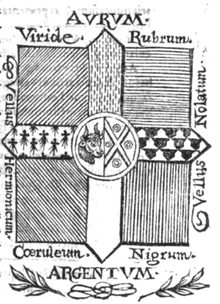
Hatching is used to indicate the colors (tinctures) in the black and white representation of coats of arms . For the individual hatching, see the tables in the Tincture section , in each case the field on the far left. An example:
Jan Baptist Zangrius from Flanders († 1606 in Leuven ) is considered to be the inventor of today's heraldic hatching. The six hatchings on his map of the coat of arms of Brabant from 1600 (see picture on the right) already correspond to those that are common today, except for a single difference in black. A second early system of hatching for the purpose of color designation, developed by Jacob Francquart from Brussels and with several deviations from Zangrius, dates back to 1623. The system adopted by the heraldry of all European states, which is now still valid, is first found in 1634/1638 in the Roman Jesuit Silvester a Petra Sancta : black as a grid of horizontal and vertical lines, otherwise the hatching as with Zangrius.
Symbols
Instead of hatching, astronomical symbols were also used. The Englishman Speelmann used these symbols around 1600.
These are the usual color attributions of alchemical use, as they were common at this time, with the exception of Mercury (mercury), which usually represents luster - according to the early color theories, as such, not differentiated from colors.
Heraldic color rule
The heraldic color rule defines how the tinctures can be used. It says: Metals must not border on metals, colors not on colors. This also means: every coat of arms must contain gold or silver. By juxtaposing metals and colors in a coat of arms, a strong contrast effect is achieved, which makes the coat of arms recognizable from a great distance. This was necessary in the Middle Ages in order to be able to identify the person opposite from a great distance.
A violation of the color rule can be found in many student coats of arms .
Proven color combinations
The juxtaposition of color and metal according to the color rule should ensure a good contrast . Four colors (red, blue, black and green) and two metals (gold and silver) allow a total of eight combinations of one color with one metal. However, the resulting contrast is not equally convincing in all combinations.
Whether a good contrast is created can also be seen from which color combinations are preferred on today's signs, with white and yellow instead of silver and gold. These combinations are easy to recognize:

|

|

|
Red and white |

|

|

|
Blue and white |

|

|
|
black and white |

|

|
|
Green and white |

|

|

|
Red and yellow |

|

|

|
black and yellow |
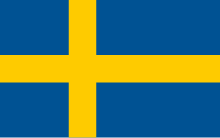
The two remaining combinations are blue and yellow (as in the coat of arms of Cremlingen ) and green and yellow (as in the coat of arms of Rudolstadt ). They often do not produce optimal contrast, especially if the brightness of the colors does not differ significantly (see pictures on the right). The unsuitability of the combination of green and yellow (or gold) is supported by a statistical evaluation of more than 20,000 coats of arms, which contain exactly one color and one metal. The result:
| combination | number |
|---|---|
| Red and silver | 6914 |
| Blue and gold | 4365 |
| Black and gold | 3655 |
| Blue and silver | 2900 |
| Red and gold | 2714 |
| Black and silver | 2398 |
| Green and silver | 816 |
| Green and gold | 469 |
Green and gold with a comparatively low contrast is by far the rarest combination, the most popular combination of red and silver appears almost 15 times more often. However, the statistics also show that the optimal contrast effect cannot be the only criterion for the choice of color and metal. Although black and white are known to offer the best contrast (almost all texts are printed in black on white), the analog combination of black and silver is only moderately popular with two-tone coats of arms, probably because it lacks color.
Necessary exceptions to the color rule
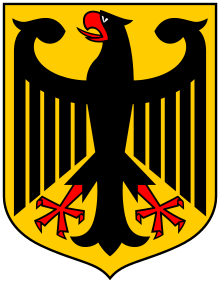
Complex coats of arms: With only two or three tincture variants (colors and metals, possibly fur), not all divisions and figures can be designed strictly according to the color rule. With the development and spread of the coats of arms, more and more complex motifs emerged, in which a softening of the rule of colors could not be avoided. The basic principle is that the more simply the coat of arms is designed, the more strictly the rule of colors must be adhered to (especially with heraldic images ).
Overlaying motifs: Basically, the large-scale juxtaposition of color on color or metal on metal is avoided. Overlays are allowed, however, and are not considered a breach of the color rule, as the overlaid motif is perceived as lying in front of or above the background. One example is the coat of arms of Senden (Westphalia) , in which a green linden tree is covered in silver by a red, four-lipped tournament collar .
Small details: Even with smaller details, such as the reinforcement of common figures, one tries, where possible, to comply with the color rule. A looser handling dictated by necessity is tolerated, e.g. B. the German federal eagle .
Association of coats of arms: When merging several coats of arms into a single one, for example when two nobles marry, the color rule is only considered within the individual coats of arms. Violations that only result from the association of coats of arms do not count as a rule break.
Riddle coat of arms
Coats of arms, the colors of which have changed significantly due to oxidation , fading or loss of a layer of paint, are referred to as “mystery coats of arms”. In particular, the technical difficulties in reproducing silver and gold have given rise to heraldic errors. Silver becomes slightly black through oxidation, or the usual blue underpainting of silver could emerge over time. The gold leaf, which originally had to be underlaid with red lead, often peeled off and then left only the red base color. Such color changes can result in an apparent violation of the color rule, as one metal (silver or gold) is replaced by a color (black, blue, red).
Another color rule
There used to be another guideline: a coat of arms should not contain more than two of the total of six colors (black, red, blue, green, gold, silver), because more colors in a coat of arms create the impression of “inconsistency”. Together with the heraldic color rule mentioned above, this means: A coat of arms should only use one of the four colors black, red, blue or green, combined with only one “metal” (gold or silver).
However, looking at real coats of arms shows that this guideline is not a strict rule, but rather a purist ideal. The statistical analysis of a very large sample resulted in the following figures, for example: a total of 30,536 coats of arms, which contain red and silver, but only 6,914 two-tone coats of arms with red and silver. Or a total of 10,772 coats of arms, which contain green and silver, but only 816 two-tone coats of arms with green and silver. The number of "ideal" two-tone coats of arms is therefore in reality significantly smaller than that of those coats of arms in which at least one other color is added.
See also
literature
- Friedrich-Karl zu Hohenlohe-Waldenburg: The heraldic fur work . Stuttgart 1867 ( digitized version ).
- Gert Oswald : Lexicon of Heraldry . Bibliographical Institute, 1984, ISBN 3-411-02149-7 .
Web links
Individual evidence
- ↑ a b c d Joseph Kürschner (Ed.): Pierers Konversations-Lexikon. With universal language lexicon according to Prof. Joseph Kürschner's system. Seventh edition, Union - Deutsche Verlagsgesellschaft, Stuttgart 1890.
- ^ Milan boys : Heraldry. Albatros Publishing House, Prague 1987.
- ↑ sable in the English Wiktionary, see Etymology.
- ↑ Gules , heraldica.org (Eng.)
- ↑ Tinctures , geocities.com (Eng.)
- ^ The Public Register of Arms, Flags and Badges of Canada - Heraldry: Leslie Graham Cairns MILLIN . Retrieved August 13, 2007.
- ↑ Otto Titan von Hefner : Handbook of theoretical and practical heraldry. Heraldisches Institut, Munich 1863, p. 83.
- ^ Walter Leonhard : The great book of heraldic art. Callwey, Munich 1978, ISBN 978-3-7667-0345-3 .
- ↑ Source: welt-der-wappen.de , Navigation: Heraldikrechte → Colors, section How popular are the individual colors in German heraldry? , Point 4.
- ↑ Source: welt-der-wappen.de , Navigation: Heraldikrechte → Colors, section How popular are the individual colors in German heraldry? , Point 2 and 4.
